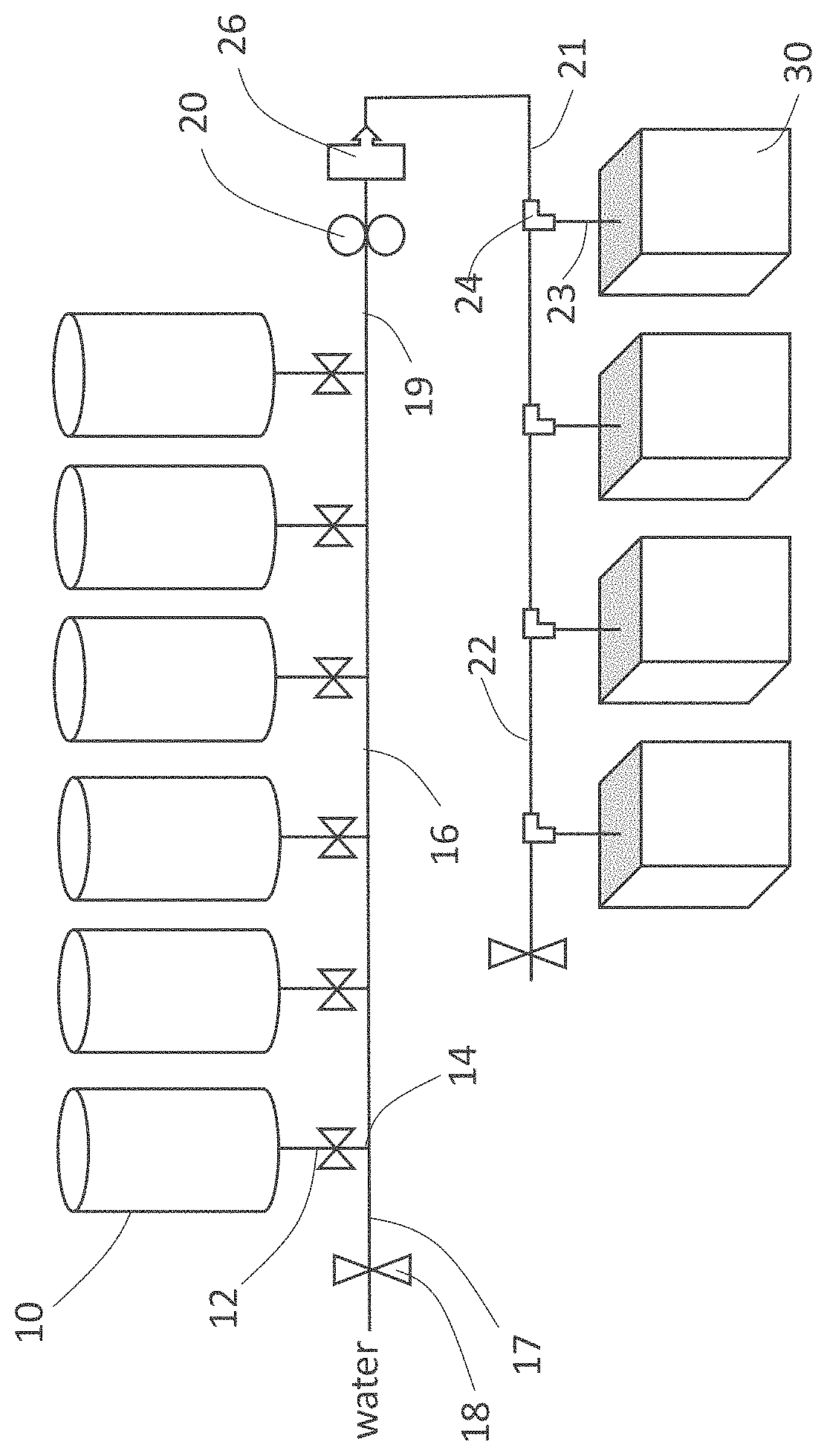Methods of laundering stitchbonded nonwoven towels using a soil release polymer
a technology of soil release and non-woven towels, which is applied in the preparation of detergent mixtures, detergent compounding agents, detergent bleaching agents, etc., can solve the problems of poor dimensional stability, poor soiling and physical abuse of products, and towels are not ideal for all of these applications, so as to improve the alkalinity of the wash solution and improve the effect of soil and stain removal
- Summary
- Abstract
- Description
- Claims
- Application Information
AI Technical Summary
Benefits of technology
Problems solved by technology
Method used
Image
Examples
example 1
sion Towels
[0097]Soiled first version towels were laundered according to the following steps:[0098](i) flushed with 100° F. flush water (FW1) for 5 minutes,[0099](ii) washed with 175° F. wash solution (Wash1) for 15 minutes;[0100](iii) rinsed three cycles of 150° F. water for 3 minutes, 150° F. water for 2 minutes, and 145° water for 2 minutes;[0101](iv) bleached with 145° F. bleach solution (Bleach1) for 10 minutes;[0102](v) rinsed three cycles with cold water for 2 minutes each;[0103](vi) treated with 100° F. sour and antichlor solution (Sour / AC1) for 4 minutes;[0104](vii) extracted (spin) for 5 minutes; and[0105](viii) dried.
[0106]This conventional wash cycle for soiled towels used a high alkaline wash formulation on non-treated, first version towels. The results were based on an average of four loads, and showed heavy soil redeposition, residual stains, and a remaining odor. The entire load was typically relaundered. These results show the effect of a lack of a SRP post-treatmen...
example 2
f First Version and Second Version Towels
[0107]A mixture of soiled first version towels and soiled second version towels were laundered according to the same steps as Example 1.
[0108]This conventional wash cycle for soiled towels used a high alkaline wash formulation, on a mixture of non-treated first version towels and SRP-treated second version towels. The results were based on an average of eight loads. The non-treated first version towels showed heavy soil redeposition, residual stains, and a remaining odor. The SRP-treated second version towels showed substantial removal of the SRP pre-treatment, and subsequent soiling and laundering showed progressively increased staining, darkening in color, and increased odor. These results shows the effect of both a lack of a SRP post-treatment on the as-manufactured white, stitchbonded nonwoven towels that included polyester fibers, and a benefit of a SRP post-treatment on the as-manufactured white, stitchbonded nonwoven towels that includ...
example 3
rsion Towels
[0109]Soiled second version towels were laundered according to the following steps:[0110](i) washed with 175° F. wash solution (Wash2) for 20 minutes;[0111](ii) rinsed two cycles of 150° F. water for 3 minutes, and 150° F. water for 2 minutes,[0112](iii) bleached with 145° F. bleach solution (Bleach2) for 15 minutes;[0113](iv) rinsed three cycles with cold water for 2 minutes each,[0114](v) treated with 100° F. sour and antichlor solution (Sour / AC1) for 4 minutes;[0115](vi) extracted (spin) for 5 minutes; and[0116](vii) dried.
[0117]This was a wash cycle for soiled, SRP-treated second-version towels, using a low alkaline wash formulation that contained soil release polymers to combat soil redeposition, as high alkalinity reduced the effectiveness of SRPs. The results were based on an average of four loads. However, the low alkalinity of the wash solution resulted in over 10% of the towels being rejected for stains of the type against which high alkaline would be effective...
PUM
| Property | Measurement | Unit |
|---|---|---|
| length | aaaaa | aaaaa |
| length | aaaaa | aaaaa |
| weight ratio | aaaaa | aaaaa |
Abstract
Description
Claims
Application Information
 Login to View More
Login to View More - R&D
- Intellectual Property
- Life Sciences
- Materials
- Tech Scout
- Unparalleled Data Quality
- Higher Quality Content
- 60% Fewer Hallucinations
Browse by: Latest US Patents, China's latest patents, Technical Efficacy Thesaurus, Application Domain, Technology Topic, Popular Technical Reports.
© 2025 PatSnap. All rights reserved.Legal|Privacy policy|Modern Slavery Act Transparency Statement|Sitemap|About US| Contact US: help@patsnap.com

